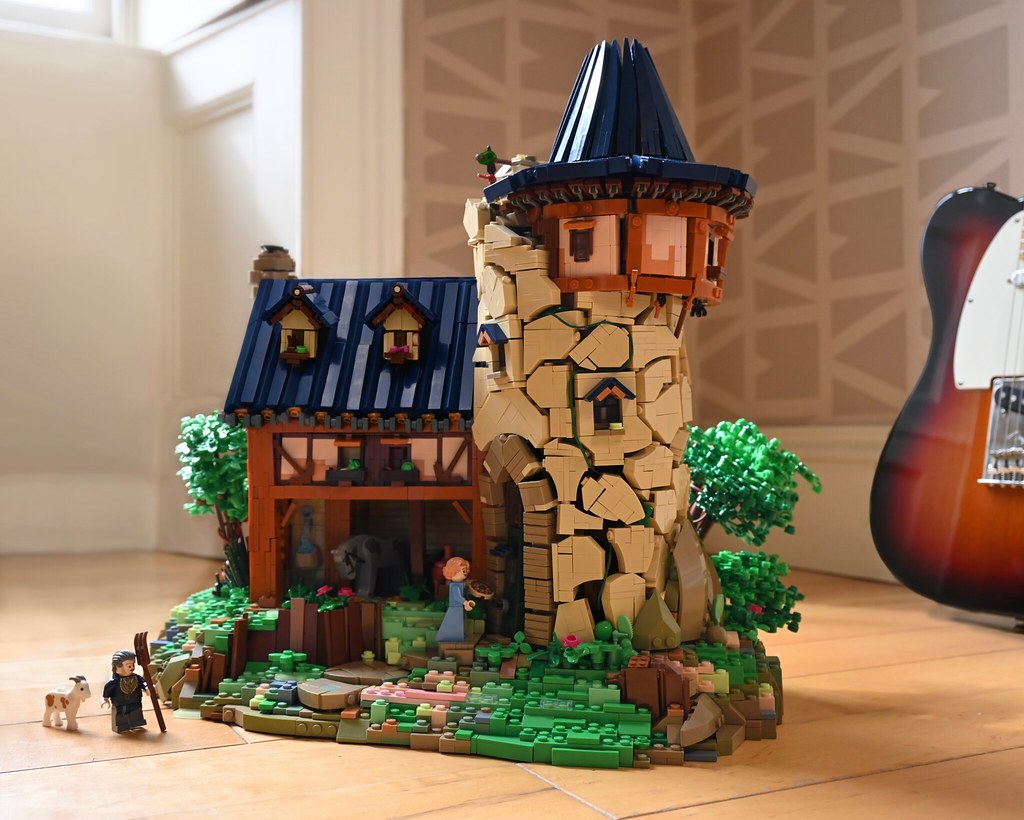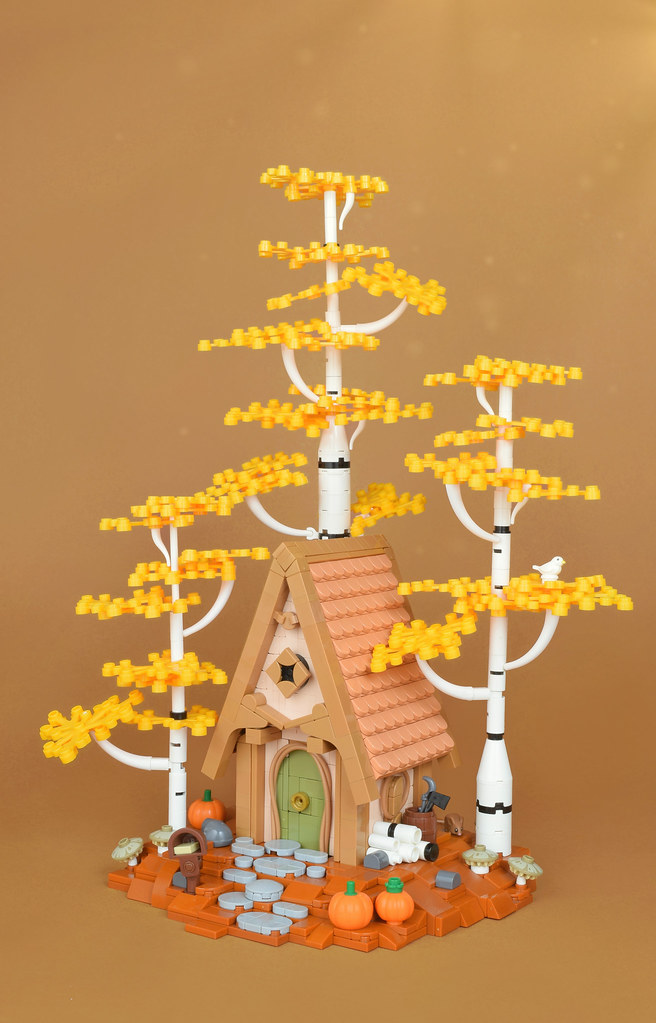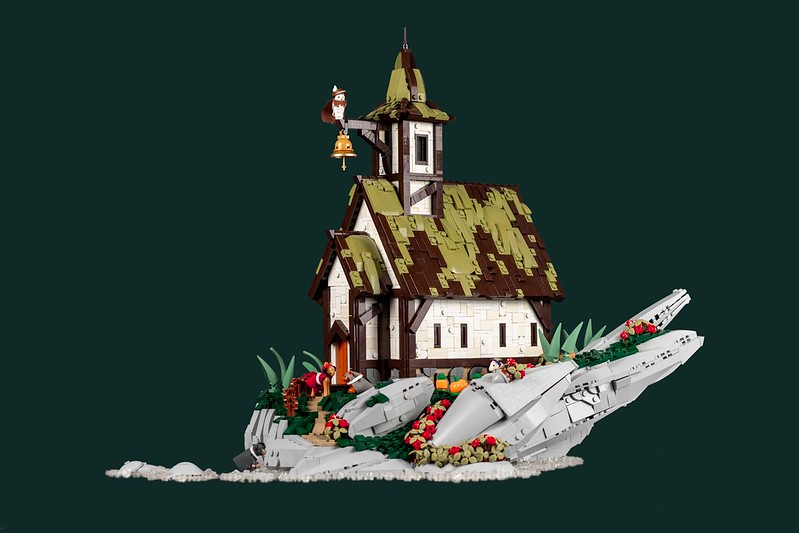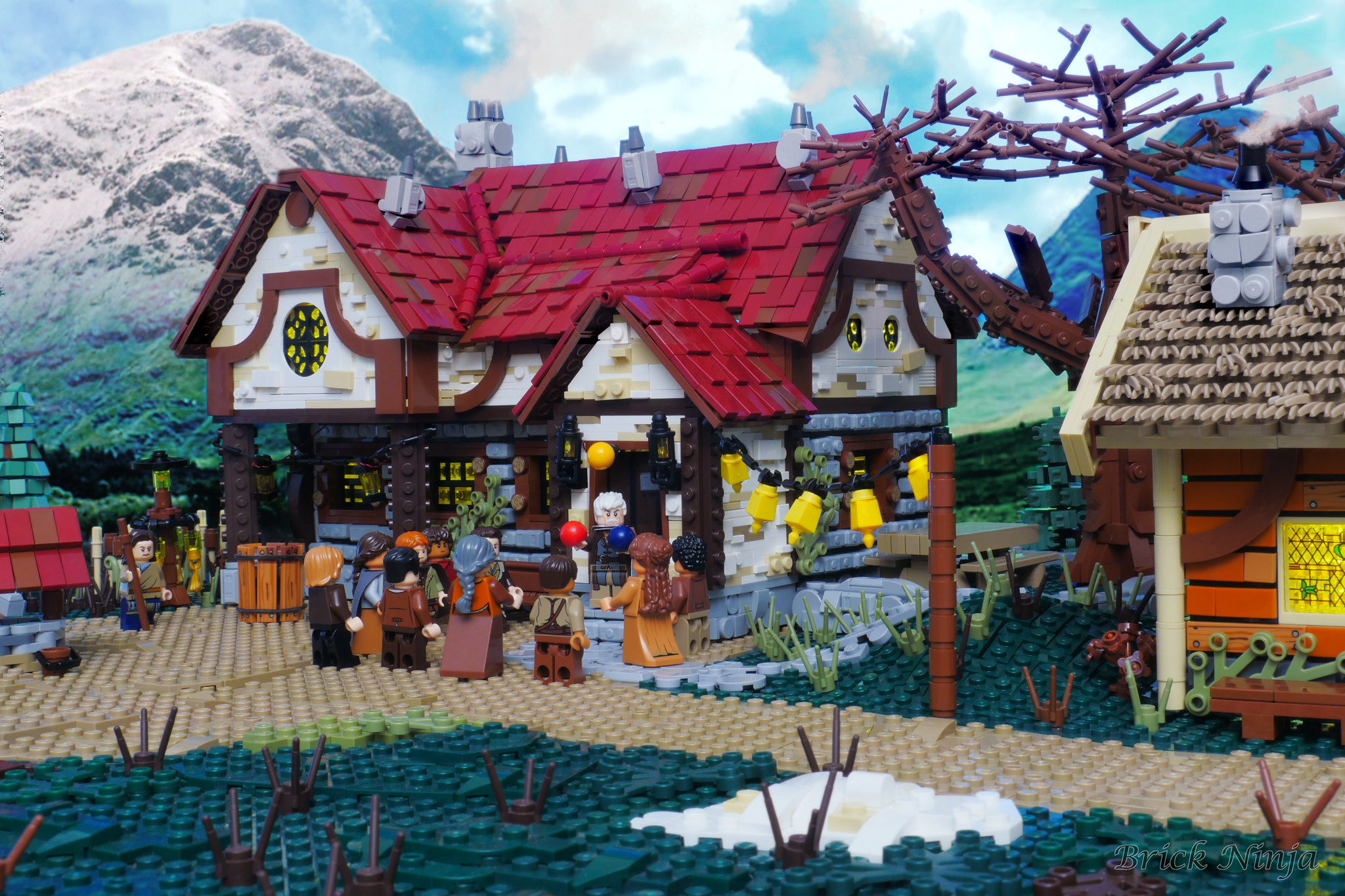There’s a feeling I get when I look at a great LEGO build, like this one by Tomasz Bartoszek! You can feel the scene drawing you in as you look for all the tiny details in this packed build. Tomasz has added a ton of designed disorder to the build that adds to the organic feel of the scene. For example, those gaps in the slats in that gate in the background are simply the gaps between bricks that aren’t pushed together. So, don’t be alarmed now if there are gaps in your brickwork. It’s just another building technique! Check out that tiny brick at the bottom of the stairs. That’s an old Modulex brick that Tomasz snuck in. Finally, the window in the door on the left is made from chain links. And don’t worry, that minstrel isn’t playing alone. The drummer will be there in four minutes!
Tag Archives: Tudor style
This tower is held together by the power of hopes and dreams
Most of the time I can figure out how a LEGO creation has been put together. Sometimes it is just a big riddle. This lovely build by Kit Nugent is one of those builds that I just can’t wrap my head around. What makes this creation really fun is the number of weird pieces hidden in it to add texture to the build. If you look closely, and I truly recommend that you do, you can spot all sorts of unique bricks. There is a pump bottle, a couple of hairbrushes and a rubber duckling hidden in the build to add texture to the landscaping. Last but definitely not least is the use of the Minecreaft pickaxe and the wand box blend in perfectly with the Tudor style of the home.
If it acts like a Bellatrix and dresses like a Bellatrix, it is most likely a witch.
Building a LEGO house in Tudor style can be really challenging. Building a LEGO house in weathered Tudor style is even harder. Although you wouldn’t say so after seeing this creation by Jaka Kunpina. They created a medieval building in the famous style and made it look so effortlessly easy. However, there are some smart techniques hidden in this build, like the hinges used to make the top of the roof overlap the building more than the rest of the roof does. And then wedges are used to cover the gap that this creates. Although her home looks lovely, the owner isn’t having a lovely day — she’s being arrested for being a witch. But then again, what do you expect when you dress like Bellatrix Lestrange.
Fall scene in the forest with fall colours
Jake Hansen drew inspiration from the fall colours for his latest LEGO creation and we need to say that it paid off. The little scene looks so peaceful. LEGO has been creating more and more bricks in new colours and at times I am struggling to identify which colours are used in fan creations. It appears this little house is created with three shades of nougat which are greatly accented by the dark orange base and the white and bright light orange leaves. The use of horns attached to the leaves of the tree instead of the base of the tree makes the tree itself look marvellous!
Everdell Chapel in the brick
Next to LEGO I am a huge board game nerd, and I love it when hobbies collide. Isaac and John Snyder drew inspiration from one of my favourite board games. Everdell is a worker placement game in which you build the homes of the many forest critters that inhabit the forest of Everdell. The artwork was done by Andrew Bosley and Dann May. The playing cards depict forest locations but also its inhabitants. The illustrations on the cards look truly as if they came straight out of a fairy tale. I can surely see why Isaac and John would draw inspiration from it. In this creation we see the Everdell chapel which is built on a rock in a foggy lake. A grey Belville tower roof has been incorporated in the landscaping and to me it is mind boggling that this large piece blends in with the scenery so well.
The resemblance to the source material is really amazing. The Tudor style is done exceptionally well, and including yellowed and damaged white bricks to depict the decay of the building is really clever. On the playing card there are no animals included but it is nice to get some forest critters in there to make the scene appear more alive. They even get cute custom outfits made out of capes and rubber bands. I am curious to see if these two will keep drawing inspiration from this lovely board game. One thing is for sure, I wouldn’t mind!
Repetition is key, but let’s not make it too obvious
Sometimes when creations get big, they lose a lot of the details which can make the build interesting. This does not apply to Tobias Goldschalt’s latest LEGO design. This Outpost Inn is so big it might as well be a Medieval version of Ninjago City. Whenever you build something this gargantuan, repetition is inevitable. The danger is that repetition is one of the key factors that can make a creation a bit boring and dull. Tobias repeated the color scheme and the architectural style of the build, however he differentiated in the details. Every section of the Tudor style mansion has a different technique. Even though all the rooftops are red, there’s a variety of texture thanks to the use of round bricks, round plates, cheese tiles and slope turrets. Additionally, the style of window construction rarely repeats itself. Avoiding repetition on this level keeps a massive creation like this interesting. You keep finding new little details every time you take a closer look at it. There is a great deal to learn from this creation if you study it closely enough.
Moist bottom or sunkissed top
This LEGO castle by lego_monkey_ is here as a reminder to all that LEGO castles can be colourful and still look amazing. The tower of this creation starts bluish dark grey, gradually fades to sand blue to end up light bluish grey on top. The ombre effect makes me question what is going on with the building. Did the bricks on top of the tower fade due to higher exposure to sunlight? Is the soil on which this tower was built very moist and are the porous bricks at the bottom of the tower soaking up the moisture? I love the addition of the bright blue colours for the rooftop. It matches the bluish tints used for the tower itself but the contrast in brightness really ups this creation. Using orange, which is the complementary colour of blue, as a backdrop is aesthetically pleasing and therefore a really smart choice.
Smaug the brick-built dragon
We’ve seen LEGO Tudor-style buildings before, and quite often the building is the main focus of the creation. We’ve also seen LEGO brick-built dragons before, and just like the Tudor-style buildings, they too tend to be the main focus of the creation. Not so for KitKat1414, however. They built an amazing Tudor-style house to represent one of the houses of Lake Town and it is lit! No literally, it is on fire!
For the woodwork on the house, Kitkat1414 used window frames and filled those in with bars to represent the wooden beams. In other places, the window frames were filled in with cheese slopes representing stained glass windows. Often these types of buildings can be very earth-toned, and while that’s mostly the case for this one, if you look closely you can spot quite a few colours being used. There is a lot of sand blue and even some lavender hidden in the roof, and the house gets a dark green door which complements the dark red Smaug in a lovely way. The dragon itself is a true work of art and there are multiple parts used in very clever ways. One that really deserves a quick mention is the use of the Bionicle minifigure legs for the dragon’s nose bridge and eye sockets. The last part that deserves a little highlight is the angled bar with stud used to represent icicles. And naturally, there are quite a few Tolkien references hidden in this wonderful build. Can you spot them all?
Lanterns with tassels!
Tudor style buildings are my weak spot. There, I said it! This build by Kevin Wanner is no exception to that rule. Kevin’s creation features stained glass windows with yellow glass. Using the turntable base for the stained glass windows is a technique that quite a lot of builders have used before, and even LEGO eventually picked up on this technique, featuring it in their Unexpected Gathering set. But there is so much more to love — the macaroni tiles in brown used for the woodwork, the crooked little chimeys, the round 1×2 plate well, the Mjolnir wall, the string net hills, the claws for a straw roof and the tree stump tiles used to show where the wooden support beams in the building are hiding. All lovely techniques, but the best one has to be the use of the old Scala perfume bottle to create a lantern with a tassel.
Tudor-style buildings with plumbing
I am quite a fan of old cities. Old cities offer a little bit of everything. They have skyscrapers and office buildings but often also Tudor-style buildings reminding us of simpler times. These Tudor-style buildings are often located near the city square or the city centre or what used to be the centre of the city. Quite often these buildings had to be modernised at a given point because they didn’t have central heating and electricity in the period they were built. Sometimes these features are added very respectfully, and it is not noticeable from the outside that these features were added on in a later stage.
Sometimes, however, these features are just slapped on the building with complete disregard of how it looks. Although I prefer the first option, I’ve grown fond of the second one too. Either way, it reminds us of our past and it shows how our demands for housing changed over the years. This build by Pieter Dennison is a perfect example of a building having to evolve in order to meet the inhabitants wishes. Pieter made a lovey Tudor-style house, complete with a stone staircase leading up to the building. Bars and slope tiles have been used to create some lovely details and even windows. Dark tan and olive-green work together wonderfully for the plaster. It looks like the building has passed the test of time. The addition of rain pipes however takes it from a medieval theme right to something more now. It gives the house a bit of a steampunk-ish vibe that we all love.









